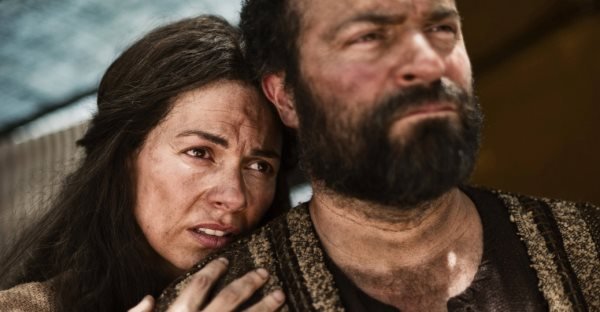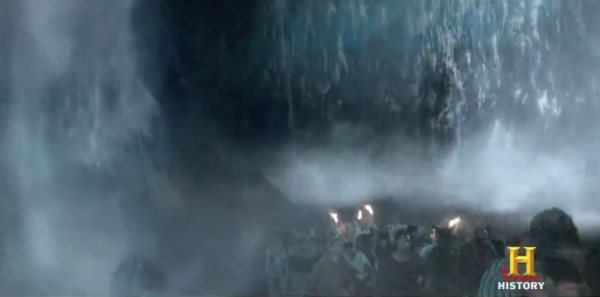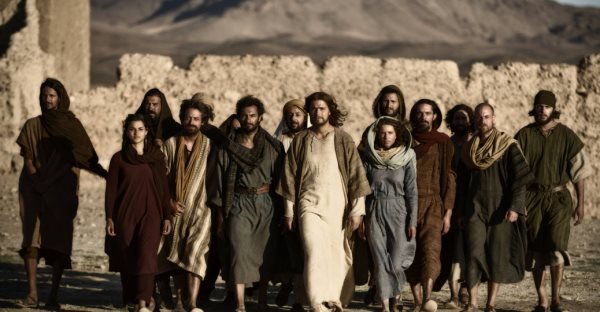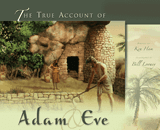
The Bible on the History Channel: A Review
The Bible Miniseries
Dr. Elizabeth Mitchell, AiG–U.S., reviews The Bible, a five-part, ten-hour docudrama, premiered on the History Channel.
Reviews of The Bible
- The Bible on the History Channel: A Review
- 27 Million Viewers, What’s Next?
- History Slips, God Seems Absent
- Jewish, Roman Leaders See Jesus as Threat
- Thoughts on the Finale
Last night, the first segment of The Bible, a five-part, ten-hour docudrama, premiered on the History Channel. This adaptation of the history recorded in the Bible is intended not only to appeal to those acquainted with the Bible but also to hold the attention of those not familiar with it. Coproducers Mark Burnett and Roma Downey have said they wished to honor God’s Word by making it memorable for viewers. Burnett said, “If you know the Bible, you’ll enjoy seeing the stories come to life. If you’ve never read the Bible, I think you’ll love the stories. There’s a reason the Bible is the most widely read book in the world.”1
In a sense this miniseries follows in the centuries-old medieval European tradition of Corpus Christi Day pageants. To teach ordinary people biblical history, each summer many towns would host a parade consisting of a series of theatrical depictions of events from the Bible. Because no such presentation could dramatize the entire Bible, the plays consisted of events that were deemed most important for understanding the Bible’s overall message and developing the background for the gospel of Jesus Christ. Such pageants typically included the account of creation, various scenes from both the Old and New Testaments, episodes from the life of Christ, Christ’s Crucifixion and Resurrection, and the Second Coming. Plays were sponsored and produced by guilds in the towns, though the established church doubtless supervised the content.
Because The Bible presents biblical history as real history in graphic, interesting, and memorable ways, it serves the same role in the twenty-first century as the cycle plays did in the fourteenth century. Though the public then was acquainted with the Bible, it was not widely available in people’s native tongues, and many could not read. Today, many people in the world are biblically illiterate even where the Bible enjoys wide circulation and despite the comparatively high rate of literacy. Though many reasons could be cited for this tragic situation, one major problem is that the historicity of the biblical narratives has been increasingly downplayed by those who claim the accounts are allegorical or metaphorical. Sadly, many who do this believe they are reconciling the Bible with science and supposedly making it more acceptable to a wider audience. Yet by eroding people’s faith in the Bible’s history, this approach actually drives people from its truth and makes the Bible seem irrelevant and not worth their time.

Noah and his family endure a miserable ride in the early portion of the Flood, but they and the animals preserved with them are safe in the massive Ark that Noah had built according to God’s command. The Bible describes the Ark in Genesis 6:11–22. Image: The Bible
Thankfully, The Bible allows the plain truths of biblical history from the time of our origins to speak and connects those truths to the relevant issues of life: why there is evil in the world (which Noah answers), how we can have faith in seemingly impossible promises (which Abraham answers), and why a powerful man can’t be a god (which Moses answers).
Though some may watch this miniseries with the idea that they are watching something allegorical, nothing in The Bible supports that contention. Even in its opening scene, a believable Noah recounts the six days of creation for his seasick family in a massive, storm-tossed Ark in a Flood that is clearly global. The worldwide scope of the Flood is portrayed by the graphic of a flooded planet and the narrator’s confirmation that the floodwaters had “engulfed the world.” Noah not only explains the reason God told him to build the Ark but also the reason for evil in the world. He lays the blame—as the Bible does—squarely on the head of human beings, beginning with Adam and Eve. People were intended to live in paradise, he explains, but Adam and Eve rebelled against God. Their disastrous choice, Noah says, was the first of countless wrong choices that led human hearts to be filled with evil. And the narrator adds that after the Flood, there was “a new beginning for Noah’s descendants and a chance to restore the relationship between God and humanity. This is The Bible.” Thus in the opening minutes of the film, the foundation is laid for God’s redemptive plan that runs throughout the Bible.

The Flood of Noah is depicted as global Flood that “engulfed the world,” a historical fact reinforced by panning out to a graphic showing a flooded planet that soon morphs into a view with continents after the water receded. God’s Word affirms that the Flood covered the entire surface of the earth in Genesis 7:19–20. Image: The Bible
The medieval Corpus Christi plays were intended to point viewers to Jesus Christ, as indicated by the holiday’s very name, which means “body of Christ.” Likewise, The Bible graphically connects the first sin by Adam and Eve to the evil that led to the need for the Flood, and the foundation is laid to discover why Christ needed to come to earth and die for the sins of mankind. Historically, God’s redemptive plan also required that God choose a man from whom to build a people through whom He would send Jesus as a blessing for the whole world. God’s promises to Abraham, scripted straight from Genesis 12:1–3, emphasize the fact that the promised Blessing, Jesus Christ, would be the Savior, not just for physical descendants of Abraham, but for all nations of the world.
By focusing on several key characters and events rather than taking a more encyclopedic approach, The Bible is able to develop believable characters that do justice to the actual people they portray. We see the many obstacles to faith in God’s promises—delays when nothing good seems to be happening, loved ones who don’t understand, personal failures real and imagined, and frustration when all avenues for fulfillment seem exhausted. All characters—from Sarah and Lot’s wife to Rahab, Samson, King Saul, and Judas—are depicted in sufficient depth for us to make sense of their motives and concerns. Adaptations of history like this are very valuable because the Bible, as long as it is, only has room to give the high points of its many historical accounts. It is easy to forget that these histories were lived by real people—both “major” and “minor” characters—who often struggled with doubt, regret, fear, and anguish.

The Bible demonstrates the difficulty of remaining faithful to God’s commands and promises through its excellent characterization of Abraham and Sarah. Their eyes of faith look forward to a fruitful future for their descendants. Nevertheless, they must endure the agonizing consequences of their own bad decisions and those of others, as well as the painful necessity of trusting God’s clear instruction even when it doesn’t seem to make sense. Image: http://www.history.com/shows/the-bible/pictures/the-bible-photo-gallery
The Bible film, like the Bible itself, does depict a world wracked by violence since Cain killed Abel. Therefore, the producers suggest this movie be considered PG-13 in terms of violence. Parents and teachers should exercise the same care in prescreening it before showing it to young children that they should exercise with other films. There is no nudity, and the two sexual scenes in the movie are handled discreetly.
Because the miniseries has a lot of time to cover—roughly 4,100 years of history in just ten hours—naturally much must be omitted and many events are compressed or shuffled. Thus, in an adaptation like this there are a few things out of order and even a few outright discrepancies with biblical history. How much each one of these troubles biblically literate viewers will vary, and as you watch with your family you may want to challenge your children to see if they can find them. (Hint: Or you could wait until the next time you play a Bible trivia game. If your daughter’s answer to “What king threw Daniel into the lions’ den?” is “Cyrus” instead of “Darius,” then you’ll score the point because she got that particular “fact” from the movie.) Nevertheless, there are plenty of biblically accurate details to satisfy the Bible-lover’s eye. And the small deviations from the biblical text are generally made to keep the story clear and connected for those unfamiliar with the Bible.
The narration enables The Bible to skip through centuries of history while still weaving a cohesive narrative. And most alterations in the cinematic adaptation do serve a purpose in the presentation. The only one I noted that seemed to weaken the overall story was an unnecessary—and biblically inaccurate—mention that the prophet Isaiah was in Babylon with Daniel when he wrote his prophecy (Isaiah 44:28 and 45:1) of Cyrus freeing the Jewish people from captivity. This notion is at odds with the biblical timeline, as the biblical Isaiah lived and wrote about 125 years before Cyrus’s birth.2 Isaiah recorded that he prophesied during the reigns of Uzziah, Jotham, Ahaz, and Hezekiah in Judea. Daniel was taken to Babylon by Nebuchadnezzar many years (and many kings) later. The idea that Isaiah only wrote of Cyrus after Cyrus appeared on the political scene, as suggested by aniel’s comment in the movie (at least in the pre-release version that I have seen) was developed by scholars who, having a low view of divine inspiration, had a difficult time believing a predictive prophecy could be so specific. The movie is weakened by this error, as the idea that a contemporary prophet’s claim that Cyrus would free the people (2 Chronicles 36:22–23 and Ezra 1:1–2) would not have impressed Cyrus at all.

The Israelites emerge from the path God provided through the Red Sea. This real historical event, described in Exodus chapter 14, is depicted with stunning graphics. Image: The Bible
Fortunately, none of the other miraculous events in the movie are weakened by such naturalistic overtones. The graphics in the Red Sea crossing—a real, historical crossing of a real sea—would make Cecil B. DeMille (the genius behind the 1956 film The Ten Commandments) proud. This is a movie that lets God be God as He inspires faith, directs individuals, and guides the events of history toward the completion of His work of salvation through Jesus Christ’s sacrificial death and Resurrection.
Jesus Christ’s words from the cross are compelling. Through the interweaving of the crucifixion with scenes in the temple, we see how His death heralded the end of the need for symbolic animal sacrifices in a system that had long since been corrupted by men. Moreover, the Passover countdown, leading up to that most pivotal moment in human history, reminds the viewer that Christ was Himself the perfect Passover sacrificial lamb (1 Corinthians 5:7). And the numerous appearances of sacrificial lambs throughout the film—harkening back to the scene with Abraham on Mount Moriah in which a lamb3 is provided by God as the sacrificial substitute for Isaac as well as to the original Passover in Egypt—make it clear that Jesus Christ is the fulfillment of God’s redemptive plan.
The Bible bids fair to help get out the word of the gospel to many people. It unfortunately lacks a clear presentation of the gospel message like hat included at the end of the 1979 Jesus Film—a film that has been used by countless missionaries around the world to acquaint people with the life of Christ as presented in the book of Luke. I have a particular affection for the inclusion of such a clear and simple explanation with an invitation to receive God’s gracious gift of salvation in Christ. Why? Because a child, who was unmoved by other explanations, once sat beside me and became reconciled to God through Jesus Christ while watching that film.

While much of The Bible of necessity uses scripted dialogue, a precious verse in which Jesus Himself summarizes the gospel is included: John 3:16. Jesus, portrayed by Diogo Morgado, with the disciples, Mary (His mother), and Mary Magdalene, in this cast photo remind us of the heritage we have to continue in taking the message of Jesus Christ to all the world. This film offers an excellent opportunity to share the gospel and the truth of God’s Word with friends who may be skeptical or simply consider the Bible irrelevant. When the gospel message is understood in the light of human history, it makes sense. Image: photo credit Joe Alblas through http://www.history.com/shows/the-bible/pictures/the-bible-cast-gallery/the-bible-28
Doubtless The Bible will also enjoy a fruitful role in the hands of churches, missionaries, and individual Christians willing to obey Christ’s Great Commission to take the good news of salvation in Christ to the world. Unless the producers add a brief gospel message to the final episode—which will air on Easter Sunday, March 31—some viewers will likely need additional explanation.
Nevertheless, even as a stand-alone production, The Bible will likely lead many to Christ. Why? Because it presents the Bible’s history as real history—instead of eroding trust in God’s Word from the very first verse. Because it demonstrates the relevance of the Fall of mankind soon after creation to all the evil that has ever cursed our world. Because it depicts the Old Testament sacrifices that God intended to prefigure the ultimate sacrifice of Christ, the Lamb of God who takes away the sin of the world (John 1:29). And because it presents the Bible’s history as a continuous narrative of God’s plans for us from creation through the covenant people of Abraham and Moses to Christ and the early church, thus showing how Jesus Christ is indeed God’s answer for the sin-guilt of the entire world.
Editor’s note: AiG gratefully acknowledges the series’ publicists in allowing us to preview the entire 10-hour series before it aired.
Note that there is a heavy use of scripted dialogue instead of actual words from Scripture. When we convey the wonderful (and completely true) stories from the Bible to our children, and to adults with whom we are privileged to teach or converse, we often paraphrase what the Bible actually reports people said or fill in the gaps with dialogue that the Scriptures do not provide. (At least, I know I have been doing that for decades, and I think I have been a fairly effective teacher and a reasonable witness, by God’s grace.) Likewise, as the opening to each episode of the movie reports, and as I wrote in the article, this film (which is not error-free) is intended to be an adaptation of the biblical history, including the conversations of our Lord. It does not claim to portray the actual words of Jesus but only attempts to convey His message and character in an abbreviated form, while tying in His earthly ministry to the historical context of the Bible.
Nothing can substitute for the actual words of Scripture, especially those words Jesus spoke during His earthly ministry. I hope this movie will lead many who otherwise possess only a dusty unused Bible—or none at all—to open it and read it for themselves. I absolutely believe that faith comes from hearing the Word of God (Romans 10:17), and I hope that presenting biblical history in a way that counteracts the skeptical world’s claims that it is allegorical or mythical will prompt many to consider the Word of God seriously and in the proper context.
Obviously, if you or your children are troubled by the presence of some factual errors, then you should consider not watching the film, and I am glad I was able to warn you of some of these issues. Other families may choose to watch it with Berean discernment (Acts 17:10–11), comparing all they see with Scripture to determine what is clearly true, what is erroneous, and what is added just to make a cohesive story. But I am confident that the docudrama’s overall fidelity to Christ’s message in the context of genuine biblical history will be a powerful testimony to many less biblically literate people who don’t quite see how “Jesus” fits in with “all the other Bible stories.”
If you missed the first episode, it will re-air Monday night on Lifetime and Wednesday on the History Channel. The series will be presented on the History Channel in the U.S. and Canada over five consecutive Sunday evenings, concluding on Easter Sunday, March 31. The schedule and additional information is available at http://www.outreach.com/the-bible/about.aspx.
- The Bad News . . . and the Good News
- Global Flood
- The Sequence of Christ’s Post-Resurrection Appearances
- Did the Resurrection Really Happen?
- The Resurrection of Jesus Christ: An Introduction
- Infallible Proofs
- Biblical and Extra-Biblical Evidences
- “The Search for the Historical Adam” and Population Genomics
Footnotes
- http://www.usatoday.com/story/life/tv/2012/12/16/history-bible-docudrama-mark-burnett-roma-downey-sneak-peek/1771069/
- For details see Floyd Nolen Jones, Chronology of the Old Testament, Master Books, copyright 1993, page 301.
- Genesis 22:13 indicates God provided a ram caught by its horns.
Recommended Resources

Answers in Genesis is an apologetics ministry, dedicated to helping Christians defend their faith and proclaim the good news of Jesus Christ.
- Customer Service 800.778.3390
- © 2024 Answers in Genesis





